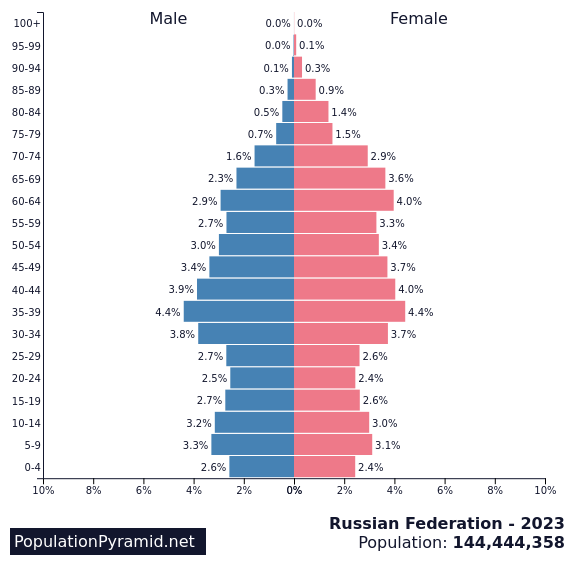And vice versa.

Population Pyramids of the World from 1950 to 2100
Russian Federation - 2023
And vice versa.
While China is working on getting stronger, others are also building up forces.
The mood in Japan is getting more assertive concering China and have ordered longer range missiles from the US as well as are in negotiations for allow the US to deploy missiles on US bases in Japan.
And the US has gotten more access in the Philippines.
Ewwwwww.
Wouldn’t that release the pressure (of negotiations) something fierce?
I read an interesting article about the demographic collapse in China - two generations of one-child families, followed by economic growth sufficient that the middle class - like the West - can’t really afford many children. Plus, the development is that more and more workforce will be diverted to caring for an elderly population.
It occurs to me at what point will the Chinese population start to worry that their precious only child/grandchild will become canon fodder to feed the PRC’s ambitions? Especially, family is far more important in China than here, and those single children are expected to look after their parents.
On the plus(??) side, a disastrous war will help equalize the imbalance in their sex ratios.
Wouldn’t that release the pressure (of negotiations) something fierce?
So… meet for negotiations in Thailand?
:: through gritted teeth ::
Must… not make… Bangkok… joke….
Regarding Chinese military’s strength, there is only one way to find out : >(
On the plus(??) side, a disastrous war will help equalize the imbalance in their sex ratios.
Not much. There are 34 million more men than women in China. Even the bloodiest war over Taiwan, for instance, isn’t likely to result in any more than a million Chinese male casualties.
In the Ukraine thread it was mentioned that due to the war and the number of men who are leaving the country to avoid conscription, there are more women than men in the Russian population.
It sound like the problems could be made to cancel out.
As I understood, excessive social problems - alcoholism, heart attacks, etc. - tended to strike men more than women, so the Russian imbalance was always there; just not as pronounced. By comparison, the Russian population of men 20-30 is approximately 8M so 80,000 is 1%. If they’ve actually lost up to 150,000 that’s 2% of the generation needed to provide replacement children (already below replacement level). Plus the ones heading for the exit are likely among the best and brightest with much of a future ahead of them, adding to the problem. Supposedly about half a million or more have fled.
Interesting site:

Russian Federation - 2023
By comparison:

China - 2023
Somewhat off topic but I remember this reporting from when I was young:

The Chinese population pyramid would seem to say that the story was untrue or a sensationalized account of a few non-representative occurrences.
So, to get on-topic, I’ll just note that it’s good to be a bit skeptical of all reporting - pro and con of anything - where it’s hard to get reliable data.
Not exactly - note the pyramid - until you get to age 50, there’s a substantive difference between the male and female population in each age group. 3.2 vs 2.8, or 4.1 vs 3.7 - that doesn’t sound like much until you realize that means there are for example in an age group 32 boys for very 28 girls, or 41 boys for every 37 girls. Considering that typically birth rates are about 51% female, that’s a consistent “statistical anomaly”.
Considering that typically birth rates are about 51% female, that’s a consistent “statistical anomaly”.
In China? Because globally, it’s more like 51% males at birth.
ETA: Found a link. China is about 58% male.
How does the sex ratio at birth vary across the world? - Our World in Data
I understand they are more powerful than a locomotive.
In China? Because globally, it’s more like 51% males at birth.
Oops sorry, got it backward.
But males are more susceptible to diseasea and other lifestyle issues, so the number of females tends to exceed males as the cohorts age…
Quite interesting to me:

It’s a growing problem that has United States naval commanders scratching their heads: How to keep up with China’s ever-expanding fleet of warships.
And also see:

China’s latest and most capable aircraft carrier has officially entered service, a significant step forward for Beijing as it seeks to catch up with the United States on naval supremacy.
They’ve got a carrier, but do they know how to actually DO carrier air operations? I suspect that the training, doctrine, and execution of that is going to be a weak point for a long time, especially when compared to the US Navy, who’s been doing that sort of thing for more than a century.
The thing this thread seems to ignore is that wars aren’t won by technology; they’re won by people and how they use that technology. And stuff like training and doctrine are really important, and it’s a place where the USN has a distinct advantage over the PLAN.
They’ve got a carrier, but do they know how to actually DO carrier air operations? I suspect that the training, doctrine, and execution of that is going to be a weak point for a long time, especially when compared to the US Navy, who’s been doing that sort of thing for more than a century.
They are working diligently at that. To be sure, a carrier is a complex thing to operate and it will take time to master but likely a few years and not a few decades.
How to tactically and strategically deploy them with a carrier-group will take some time too but again, probably a few years. China is working to be a global superpower.